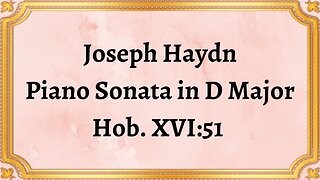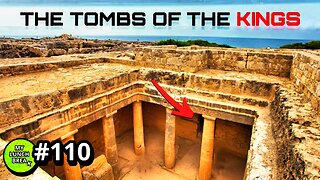Premium Only Content

Wolfgang Amadeus Mozart Piano Concerto №9 In E Flat Major, K 271
#classicalmusic #Mozart #PianoConcertoNo9 #EFlatMajor #K271 #musicalcomposition #classicalcomposer #pianoconcerto #orchestralmusic #Mozartsconcerto #classicalrepertoire
Publication date 1951
THE PHILHARMONIA ORCHESTRA, WALTER SUSSKIND, Conductor
Wolfgang Amadeus Mozart, a prodigious composer of the Classical era, left an enduring legacy of musical brilliance. Among his numerous compositions, Piano Concerto No. 9 in E-flat Major, K. 271 stands as a testament to his extraordinary talent and artistry.
Composed in 1777 when Mozart was just 21 years old, Piano Concerto No. 9, also known as the "Jeunehomme Concerto," marked a significant milestone in Mozart's career. It was written during his visit to Mannheim and Paris, where he encountered new musical influences that shaped his compositional style. This concerto showcases Mozart's maturity as a composer and his command over the piano concerto genre.
Piano Concerto No. 9 follows the traditional three-movement structure of a classical concerto. The opening movement, Allegro, immediately captivates listeners with its lively and spirited melodies. The second movement, Andantino, introduces a contrasting mood, evoking a sense of elegance and introspection. The concerto concludes with a vibrant and virtuosic third movement, Rondo: Presto, showcasing Mozart's technical brilliance as a pianist.
Mozart's Piano Concerto No. 9 is a testament to his exceptional ability to seamlessly blend solo piano passages with orchestral accompaniment. The concerto showcases his melodic inventiveness, harmonic richness, and masterful use of dynamics. The solo piano part, characterized by its lyricism and virtuosity, intertwines with the orchestra, creating a harmonious dialogue between the two. This concerto exemplifies Mozart's ability to create music that is both emotionally captivating and intellectually stimulating.
Piano Concerto No. 9 has had a profound impact on the classical music world. Its innovative and expressive qualities have influenced generations of composers and performers. The concerto's technical demands and musical depth continue to challenge and inspire pianists to this day. Mozart's ability to create a perfect balance between the soloist and the orchestra in this concerto became a model for future composers, making it a cornerstone of the piano concerto repertoire.
Wolfgang Amadeus Mozart's Piano Concerto No. 9 in E-flat Major, K. 271, stands as a testament to his genius and musical prowess. Its sublime melodies, exquisite harmonies, and virtuosic piano passages demonstrate Mozart's unparalleled ability to create timeless and captivating music. This concerto continues to captivate audiences and musicians alike, serving as a testament to the enduring legacy of Mozart and the power of classical music. Exploring Piano Concerto No. 9 is an invitation to embark on a musical journey that will undoubtedly deepen one's appreciation for the brilliance of Mozart's compositions and his significant contributions to the classical repertoire.
You have the opportunity to support the channel https://destream.net/live/RadSiarAl/donate
-
 6:07
6:07
Classical music_Music Inspiration
21 hours agoJoseph Haydn Piano Sonata in D Major, Hob. XVI:51
161 -
 4:13:39
4:13:39
Nobodies Gaming
9 hours ago $15.47 earnedNobodies : Rumble Gaming MARVEL RIVALS
86.5K6 -
 24:08
24:08
MYLUNCHBREAK CHANNEL PAGE
1 day agoUnder The Necropolis - Pt 4
88.6K27 -
 19:52
19:52
Adam Does Movies
6 hours ago $2.36 earnedEmilia Pérez Movie Review - It's Uniquely Awful
27.3K3 -
 20:07
20:07
BlackDiamondGunsandGear
12 hours agoSPRINGFIELD ECHELON COMPACT / NOT GOOD
34.2K3 -
 1:05:06
1:05:06
Man in America
12 hours agoThe Terrifying Truth Behind Chemical Fog, Wildfire Smoke & Chemtrails w/ Dr. Robert Young
27.7K27 -
 2:54:47
2:54:47
Tundra Tactical
5 hours ago $1.03 earnedSHOT Show 2025 Wrap Up!! On The Worlds Okayest Gun Live Stream
27.9K -
 LIVE
LIVE
Right Side Broadcasting Network
1 day agoLIVE REPLAY: President Donald J. Trump Holds His First Rally After Inauguration in Las Vegas - 1/25/25
3,670 watching -
 2:55:24
2:55:24
Jewels Jones Live ®
1 day agoWEEK ONE IN REVIEW | A Political Rendezvous - Ep. 107
115K39 -
 1:33:29
1:33:29
Michael Franzese
1 day agoTrump Wastes No Time: Breaking Down Trump’s First Week Executive Orders | LIVE
126K92